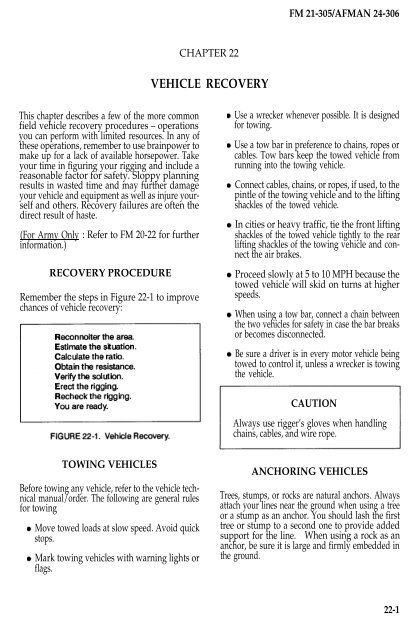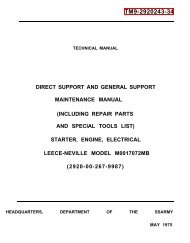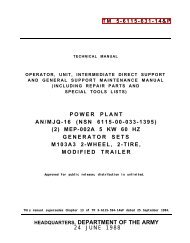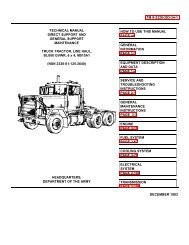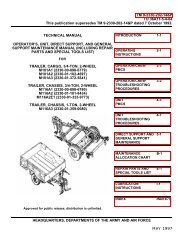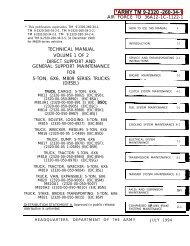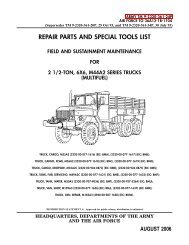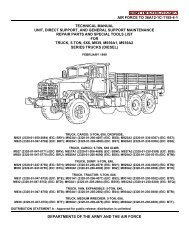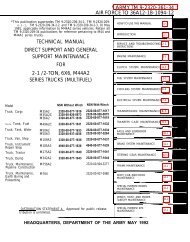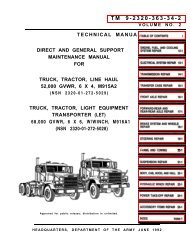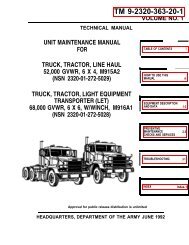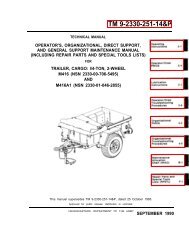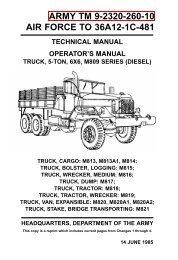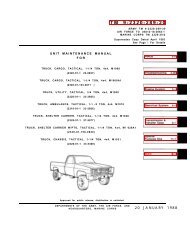VEHICLE RECOVERY - Pirate4x4.Com
VEHICLE RECOVERY - Pirate4x4.Com
VEHICLE RECOVERY - Pirate4x4.Com
You also want an ePaper? Increase the reach of your titles
YUMPU automatically turns print PDFs into web optimized ePapers that Google loves.
FM 21-305/AFMAN 24-306CHAPTER 22<strong>VEHICLE</strong> <strong>RECOVERY</strong>This chapter describes a few of the more commonfield vehicle recovery procedures – operationsyou can perform with limited resources. In any ofthese operations, remember to use brainpower tomake up for a lack of available horsepower. Takeyour time in figuring your rigging and include areasonable factor for safety. Sloppy planningresults in wasted time and may further damageyour vehicle and equipment as well as injure yourselfand others. Recovery failures are often thedirect result of haste.(For Army Only : Refer to FM 20-22 for furtherinformation.)<strong>RECOVERY</strong> PROCEDURERemember the steps in Figure 22-1 to improvechances of vehicle recovery:Use a wrecker whenever possible. It is designedfor towing.Use a tow bar in preference to chains, ropes orcables. Tow bars keep the towed vehicle fromrunning into the towing vehicle.Connect cables, chains, or ropes, if used, to thepintle of the towing vehicle and to the liftingshackles of the towed vehicle.In cities or heavy traffic, tie the front liftingshackles of the towed vehicle tightly to the rearlifting shackles of the towing vehicle and connectthe air brakes.Proceed slowly at 5 to 10 MPH because thetowed vehicle will skid on turns at higherspeeds.When using a tow bar, connect a chain betweenthe two vehicles for safety in case the bar breaksor becomes disconnected.Be sure a driver is in every motor vehicle beingtowed to control it, unless a wrecker is towingthe vehicle.CAUTIONAlways use rigger’s gloves when handlingchains, cables, and wire rope.TOWING <strong>VEHICLE</strong>SBefore towing any vehicle, refer to the vehicle technicalmanual/order. The following are general rulesfor towingMove towed loads at slow speed. Avoid quickstops.Mark towing vehicles with warning lights orflags.ANCHORING <strong>VEHICLE</strong>STrees, stumps, or rocks are natural anchors. Alwaysattach your lines near the ground when using a treeor a stump as an anchor. You should lash the firsttree or stump to a second one to provide addedsupport for the line. When using a rock as ananchor, be sure it is large and firmly embedded inthe ground.22-1
FM 21-305/AFMAN 24-306Construct anchors when natural ones are not available.The deadman is one of the best types of constructedanchors and can be used for heavy loads(Figure 22-2). It consists of a log timber, steelbeam, or other similar object buried in the groundwith a deadline connected to it at the center. Toconstruct a deadman, follow these steps:Select a place where the direction of pull is asnearly horizontal as possible, such as a sharpbank or crest. Thus, you obtain moreholding power with less digging.When digging slant the bank at least 15degrees from the vertical and undercut towardthe disabled vehicle.Drive stakes in front of the deadman at eachend to hold it in place.Tie the deadline to the center of the deadmanso the main or standing part of the line leadsfrom the bottom of the deadman. Dig anarrow trench for the deadline; bear to thecenter of the deadman. If the deadline has atendency to cut into the ground, place a log orplank under the line at the outlet from theinclined trench.Tie the deadline to the center of the deadmanso the main part of the line leads to thebottom. This will keep the deadman fromrotating out of the hold. -WINCH <strong>RECOVERY</strong>Many military trucks are equipped with winches.how how to get the most from a winch withoutdanger to personnel or abuse to the equipment.For Army Only: Your vehicle technical manualcompletely describes the winch on your vehicleand details of its operation, care, and maintenance.FM 20-22 explains general characteristics, effectivecapacities, and details for use.To ensure your safety, the protection of your equipment,and the success of your recovery operation,use the following as a guide:Check the capacity of your winch. Thecapacity shown on the manufacturer’s plate isthe maximum with one layer of cable on thedrum. Each successive layer increases thediameter of the drum and reduces the winchcapacity to as little as 50 percent of the ratedcapacity when the last layer is being wound onthe drum.Check the cable for rust, kirks, or frays.Estimate the total resistance. Consider grade orslope, weight of the vehicle, and type of terrain.Then add a reasonable factor for safety.Check your equipment. Be sure you rig safelyto overcome the resistance with the equipmentavailable.Select or provide a suitable anchor.Remember, the purpose of this operation isto recover a vehicle, not to pull stumps.Rig and check rigging. Do not put power onyour winch until you check every element inyour rigging and are satisfied that you madeno mistakes.Clear personnel from the danger area. Allpersons observing the operation should standoutside the angle formed by the cable understress at a distance at least equal to thedistance between the two most distant pointsin the rigging. Clear personnel away beforetightening the cable.22-2
FM 21-305/AFMAN 24-306Single-Vehicle Winch OperationIf you have been individually dispatched and getinto a spot where your traction is not enough to getyou through, use your winch and suitable rigging topull you through or get you back to solid footing.Working alone or with your crew, recovery maytake time, but do not skimp on planning. Yourtraining should keep you out of the really bad spots,and if you remain calm, you should get through byapplying a little extra effort.Vehicle Without Winch (Dual Wheels). Dual wheelsand ropes may be used to winch out vehicles notequipped with winches (Figure 22-4). Fasten oneend of each rope to a rear wheel hub and the otherto an anchor. Place the rope between the duals andthrough one of the holes in the wheel disk. Tie therope around the hub where it will be clear of thevalve stem. Move the vehicle in reverse gear towind the rope.Vehicle With Winch. Select or construct a stronganchor. Attach a snatch block to the anchor withyour tow chain. Run the winch cable throughthe block and back to the truck (Figure 22-3).Take up the slack gradually and pull the truckforward with its winch. Power may be applied tothe wheels at the same time. Your vehicle technicalmanual/order technical order gives details on theoperation.22-3
FM 21-305/AFMAN 24-306Vehicle Without Winch (Single Wheels). Place a barthrough the hole in the end of the axle flange of eachrear wheel. On each wheel, fasten one end of therope to the bar and the other to an anchor. Movethe vehicle in reverse gear to wind the rope in behindthe bar (File 22-5). This procedure cannot be usedon vehicles equipped with a Center Tire InflationSystem (CTIS).Two-Vehicle Winch OperationMechanical advantage is gained by using amechanism to transmit force. A small force, whenmoved through a long distance by one or moremechanisms (pulleys), will move a large weight(vehicle) for a short distance. Use one of the followingprocedures when rigging for greater mechanicaladvantage.Two-Part Line. This simple hookup gives a 2:1mechanical advantage (Figure 22-6). Attach asnatch block to the load. Next, run your winch cablethrough the block and secure the cable to the winchvehicle. Place a log in front of the towing vehicle tohelp hold its ground.Three-Part Line. To get a mechanical advantage of31, use two snatch blocks – one at the load and oneon the winch vehicle (Figure 22-7). Thread thewinch cable first through the block on the load, backthrough the block on the winch, and then again tothe load where it is secured.Four-Part Line. To get a 4:1 mechanical advantage,use two snatch blocks – a double-sheave block forthe load and a single-sheave block for the winchvehicle (Figure 22-8). Thread the winch cablethrough one sheave of the double block attached tothe load back through the single sheave on the winchvehicle, and again to the load through the secondsheave of the double block. Finally secure it to thewinch vehicle.Winch SafetyCable. Recovery operations take time. Do nothurry. A broken winch line reacts like a whip. Whenhooking to a vehicle, use both shackles wheneverpossible so effort is applied equally and damage tothe vehicle is minimized.Never bend the wire cable at a sharp angle.Straighten out all kinks and twists as you take up theslack. Do not let tractors or vehicles with metaltracks run over the cable. Such abuse flattens thecable, exposes the Manila hemp core, and lets waterenter, causing internal rust and weakening the cable.WARNINGStand clear of a winch cable before it istightened. A cable being tightened maybreak and whip back with enough force toseriously maim or kill.After using the winch, have one person or preferablytwo pull back on the cable while it is wound slowlyand evenly on the drum in accordance with theappropriate vehicle operator -10 TM. Keep thecable lubricated according to the vehicle lubricationorder.Shear Pin. When the winch is overloaded, theshear pin breaks to protect the cable. Never usemakeshift shearing of unknown strength toreplace a broken pin. Too strong a pin may snapthe cable and damage the winch. Use onlyauthorized replacement pins. Do not depend onthe shear pin for protection. Even with the properpin installed, a kinked, damaged, or weakenedcable may snap. Vehicles with electric wincheshave circuit breakers to protect the winch fromoverloading. Check the appropriate vehicleoperator -10 TM for correct winch.22-4
FM 21-305/AFMAN 24-306MAN POWER <strong>RECOVERY</strong>Recovery operations with limited man power andmaterial at hand can be successful if you haveenough time.If your vehicle has dropped into a hole or ditch,man power can get it out. First, find an 8-footlength of timber or similar material with a diameterthat available personnel can handle. Place asuitable fulcrum near the point of lift — a log orrock that will not move when pressure is applied.Rig the lever under the bumper for the first lift.Block when you have gained all you can. Rerig fora second lift with the point of the lever under theaxle if possible. Lift and block. Repeat these stepsuntil the vehicle can be backed off without toomuch trouble.If you are alone and must move a light vehicle ashort distance without power, use a lever. You willneed a fairly long pole or crowbar, a rope, cable, orchain, and a suitable anchorage for the point of thebar. The distance from the lever to the point of attachmentof the tow rope must be quite short togive you enough advantage. You will not move veryfar at each try, but you will be able to move slowly.22-5
FM 21-306/AFMAN 24-306A-FRAME <strong>RECOVERY</strong>Narrow ditches, slit trenches, and shell holes canquickly stop your truck. They are commonobstacles to off-road movement and maybe hard tosee. If your front wheels should drop into one, theA-frame is a very useful recovery tool (Figures 22-9and 22- 10). It is not very difficult to put togethernor too complicated to use. You need two 8-footpoles with a large enough diameter to support thefront end of your truck. Lash them together nearthe top with a figure eight or girth knot; use yourtow chain or a length of rope. Dig two 10- to 12-inch holes 5 or 6 feet apart to hold the legs in positionwhen power is applied. Rest the upper end ofthe A-frame on the hood of the truck with the legsin the anchor holes. Select a suitable anchor infront of the truck. Tie a line from the A-frame jointto the anchor, bringing the frame up to a positionwhere the frame joint is directly over or slightly tothe rear of the bumper. Move your winch linethrough a snatch block fastened to the A-framejoint and secure it to the front bumper.Winch up the front end of the truck until thewheels clear the ditch. Then slowly back thevehicle off to solid ground. When safely awayfrom the edge of the ditch, lower the wheels andunhitch your rig. If you have no winch, anothervehicle may be used for power, though more riggingwill be required.FIELD EXPEDIENTSField expedients are one-time emergency operationsor procedures that you may use to get out oftight spots during tactical operations. Use expeclientsonly under unusual or emergency conditions.The equipment is usually prepared as needed frommaterials at hand, most of which are designed orintended to serve another purpose. For instance,tire chains used as tow chains area field expedient.A truck tarpaulin used to wrap a l/4-ton truck tofloat it across a river is another example. The listof field expedients that have been successfully usedis long. It is beyond the scope of this text todescribe all of them. However, the few describedbelow give you an idea of the possibilities.Substitutes for a JackIf an outside dual is flat, a practical substitute for ajack is to run the inside dual up on a small rock orlog. This lifts the outside tire off the ground so youcan change the tire.Another simple method, good for any wheel on an allwheeldrive vehicle, is to rig an inclined plane withtwo logs of suitable size (or a stone and a log)(Figure 22-11). When the vehicle is driven ahead theaxle is pushed up the log until the wheel clears theground. Set brakes and block the vehicle securely.You can easily back off when your job is completed.22-6
FM 21-305/AFMAN 24-306To raise the front end, make your own bumperjack by fastening a 5-foot piece of timber at anangle to the front bumper with a chain or rope(Figure 22-12). Move your vehicle backward untilthe timber is vertical and the wheel clears theground. Set brakes and block the vehicle securelybefore working on the tire. When through, pullforward and unhitch.Method for Raising a WheelIf one of your driving wheels falls in a deep hole, youcan get out with a log and a chain (Figure 22-13).Chain the log to the wheel and move forward slowlyto prevent spinning. If the wheel spins, the log willdamage the fender or other parts of your vehicle.After clearing the hole, force the log under thewheel to keep it from falling back into the hole.Use of a SkidA flat tire or bad wheel that you cannot repairshould not stop your four-wheel drive (4 x 4)22-7
FM 21-305/AFMAN 24-306vehicle. Use a skid on the rear wheels only(Figure 22-14). If necessary, change wheels fromone hub to another. Use a skid in the followingmanner:Obtain a pole 4 inches in diameter and 6 to 8feet long.Place one end of the pole above the crossmember near the transmission and the otherend on the ground.Pass the pole under the spring U-bolts, align itwith the spring and lash it securely to thespring.Move the vehicle, using front-wheel drive.Starting will be difficult, but once moving, thevehicle will ride and handle surprisingly well.Substitutes for Tire ChainRope or tow chains can be wrapped around thewheels as tire chain substitutes. Fasten themsecurely, but leave slack around the tires to preventdamage. Remember, these are only temporary substitutes.Remove them as soon as possible.Engine Failures During Field DrivingFuel or ignition troubles commonly cause enginefailures in the field. You can correct some ofthese by field expedients, but remember, theseare only field expedients, not repairs. Inform yourunit maintenance personnel as soon as possible sothat proper repairs can be made, if necessary. Afew of these field expedients are described below.22-8
FM 21-305/AFMAN 24-306(For Army Only : More field expedients areexplained in FM 20-22 and appropriate operatorvehicle -10 TM.)Shorted Distributor Cap. A cracked distributor capwill cause your engine to miss and backfire, particularlyin damp weather when the crack is filledwith moisture. To correct this, carefully clean anddry the distributor cap, scrape the crack or runner,and fill the crack with tar or other sticky material(Figure 22-15).Frozen Fuel Lines. Condensation in your fuel tankmay get into the fuel lines and freeze in cold weather.This effectively cuts off the fuel supply to your carburetor.Thaw out these spots using hot water.Never use a flame or any device that could cause aspark directly on the line.Leaking Line Fitting. Leaks at fuel line fittings candevelop from the vibrations caused by cross-countryoperation and may result in an extremely dangerouscondition if not discovered and corrected promptly.To correct this deficiency, unscrew the coupling nut,wind a piece of string clockwise behind the flare,slide the coupling nut over this temporary gasket,and tighten with a wrench (Figure 22-17).Broken Distributor Point Spring. If your engine cutsout, stops, and cannot be restarted, the cause maybe a broken distributor point spring. Take off thedistributor cap and if this is the cause, cut a pieceof rubber from a tire and double it behind thespring (Figure 22- 16). The engine will then startand operate at slow speeds. The rubber substitutecannot close the point fast enough for high-speedoperation.Fuel Pump Vapor Lock High temperatures vaporizinggasoline in the fuel line causes this failure. Thefuel pump will not pump vapor. Soak a cloth inwater and place it over the fuel pump (Figure 22-18)to cool the fuel pump and condensate the vapor.The evaporation of moisture from the cloth has arefrigerating action that is most effective in hot, dryclimates.Other. Two other common occurrences that candamage your engine are a punctured radiator and abroken fan belt.If you have a punctured radiator, cut the cooling fins.Push them back from the tubes in front of the leakytubes so you have enough room to work. Cut theleaking tube in half and fold the ends back threequartersof an inch. Close the ends by pressing themflat with pliers. This repair may hold permanently,22-9
FM 21-305/AFMAN 24-306but radiator efficiency is reduced when several tubesare cut, and the engine may overheat.If you have a broken fan belt and no availablereplacement, use a fiber rope from the vehicletarpaulin or a piece of field telephone wire. Loopthe rope around the pulley three or four times andtie with a square knot. Find and replace faulty fanbelts during your daily maintenance service andinspection.22-10


